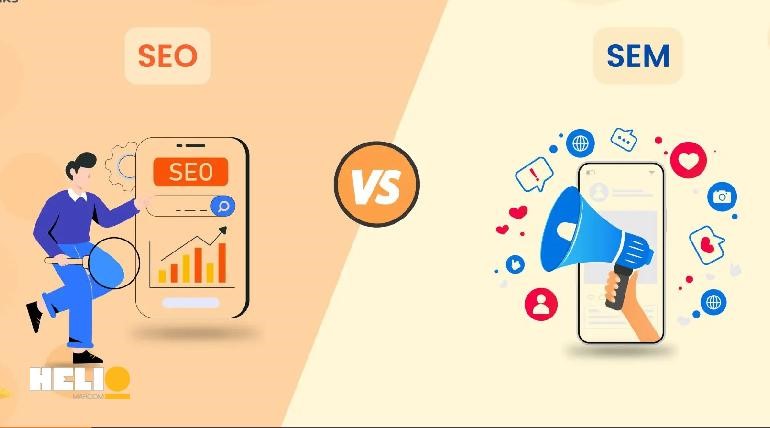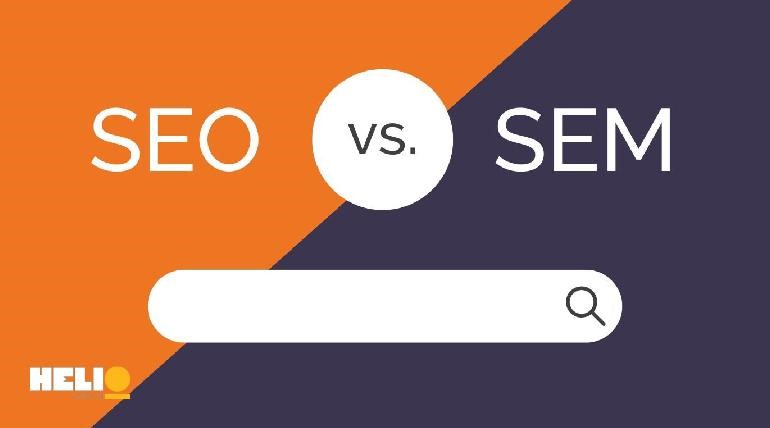In the fast-paced world of digital marketing, understanding the different strategies available to boost your online presence is crucial. Three of the most talked-about methods are SEO (Search Engine Optimization), SEM (Search Engine Marketing), and PPC (Pay-Per-Click) advertising. This guide aims to demystify these terms, outline their fundamental differences, and help you decide which strategy or combination of strategies—best suits your business.
By the end of this post, Helio guide, you’ll clearly understand how SEO, SEM, and PPC can work for you and how to implement them effectively.
What Are SEO Basics?
SEO is optimizing your website and its content to increase organic (non-paid) traffic from search engines like Google. Organic traffic is significant because it’s a sign that your website provides valuable, relevant information to visitors. When done well, SEO can improve your website’s position in search engine results pages (SERPs), making you more visible to potential customers.
Definition and Key Elements of SEO
Search Engine Optimization (SEO) is organically optimizing your website to rank higher in search engine results pages (SERPs). SEO is a long-term strategy focusing on increasing your site’s visibility without paying for placement.
Critical elements of SEO include:
- On-Page SEO: Optimizing individual pages on your site to rank higher.
- Off-Page SEO: Building backlinks and improving site authority.
- Technical SEO: Enhancing site speed, mobile-friendliness, and indexing.
- Local SEO: Optimizing your online presence to attract local customers.
Importance of SEO for Website Visibility and Traffic Generation
SEO is vital for improving your website’s visibility. Higher rankings on SERPs lead to increased organic traffic, which can result in more leads and conversions. Unlike paid advertising, SEO can offer sustainable long-term benefits.
Process of Improving Website Ranking in Search Results
Improving your website’s ranking involves:
- Conducting keyword research.
- Optimizing on-page content and meta tags.
- Building high-quality backlinks.
- Ensuring technical aspects of your site are up to par.
- Continuously updating and refreshing content.
Difference Between SEO and PPC
SEO and PPC are both strategies to improve your website’s visibility and drive traffic, but they have distinct differences.
Definition and Distinction Between SEO and PPC
While SEO focuses on organic traffic, Pay-Per-Click (PPC) advertising is a paid method to appear at the top of SERPs. When you run a PPC campaign, you pay each time someone clicks on your ad.
Focus on Organic Traffic (SEO) vs. Paid Advertising (PPC)
SEO aims to attract organic traffic by improving your site’s relevance and authority. On the other hand, PPC allows you to bid for ad placements, guaranteeing visibility as long as you’re willing to pay.
Comparison of Strategies and Outcomes
- SEO: Long-term investment, slower results, sustainable traffic.
- PPC: Immediate visibility, faster results, and costs can add up quickly.

How SEO Drives Traffic and Conversion
The main goal of SEO is to drive targeted, organic traffic to your website. By optimizing your site with relevant keywords, building backlinks, and improving technical aspects, you can attract valuable visitors who are more likely to convert into customers.
Explanation of On-Page SEO, Off-Page SEO, Technical SEO, and Local SEO
- On-Page SEO: Involves optimizing content, headlines, and HTML tags.
- Off-Page SEO: Focuses on acquiring backlinks from authoritative sites.
- Technical SEO: Ensures your website is well-structured and fast.
- Local SEO: Optimizes your business for local search queries.
Importance of Each Aspect in Driving Organic Traffic
Each component plays a crucial role in driving organic traffic. On-page SEO ensures your content is relevant, off-page SEO builds authority, technical SEO improves usability, and local SEO targets nearby customers.
Timeline and Cost of SEO Implementation
SEO is not a quick fix and requires ongoing effort. The timeline for seeing results varies depending on your industry’s competitiveness, the quality of your SEO efforts, and the age of your website. Generally, it can take 4-6 months to start seeing significant improvements in rankings.
The cost of implementing SEO also varies depending on factors such as the size and complexity of your site and whether you outsource to an agency or handle it in-house. Viewing SEO as a long-term investment rather than a one-time cost is important.
Typical Timeframe for Seeing Results from SEO Efforts
SEO is a long-term strategy. While some improvements can be seen within a few months, significant results often take 6-12 months.
Cost Considerations and Affordability of SEO Packages
SEO costs vary widely depending on your industry’s complexity and competitiveness. However, it’s generally more affordable in the long run than continuous PPC spending.
Introduction to SEM and Its Benefits
While SEO focuses on improving organic traffic, Search Engine Marketing (SEM) encompasses both paid and organic strategies to increase website visibility and drive traffic.
Definition and Key Elements of SEM
Search Engine Marketing (SEM) is a broader term encompassing both SEO and PPC. SEM aims to increase your visibility in SERPs through organic and paid methods.
Relationship Between SEM, SEO, and PPC
SEM combines SEO techniques and PPC advertising to maximize your reach and visibility on search engines.
How SEM Works and Its Benefits for Businesses
SEM targets specific keywords and bids for ad placements on search engines. It can offer immediate visibility while also improving organic rankings through SEO efforts. The benefits of SEM for businesses include increased website traffic, improved brand awareness, and potentially higher conversions.
Description of SEM Strategies, Including PPC Marketing
SEM strategies involve keyword research, optimizing ad copy, and using data analytics to refine both SEO and PPC efforts.
Importance of SEM in Expanding Online Visibility and Competitiveness
SEM provides a comprehensive approach to digital marketing, allowing businesses to dominate both organic and paid search results, thereby increasing overall visibility and competitiveness.
Timeline and Cost of SEM Implementation
The timeline and cost of implementing SEM will vary depending on your industry’s competitiveness, your strategies’ effectiveness, and your budget. It’s essential to monitor and adjust SEM efforts to ensure maximum ROI continually.
Timeframe for Implementing SEM Campaigns and Seeing Results
SEM campaigns can yield quicker results than SEO alone, primarily through PPC. However, the maximum benefit is seen with a well-rounded strategy that includes ongoing SEO efforts.
Average Costs Associated with SEM, Including PPC Advertising
Costs can vary based on competition and industry. PPC costs are immediate and variable, while SEO costs are more fixed and spread over time.
Introduction to PPC and Its Benefits
Pay-Per-Click (PPC) advertising is a paid search method that allows businesses to bid for ad placement on search engines. It offers immediate visibility, targeted reach, and can be highly effective in driving conversions.
Definition and Key Elements of PPC Advertising
PPC is a form of online advertising in which you pay each time someone clicks on your ad. It’s a way to buy visits to your site rather than earn them organically.
Comparison with Other Forms of Online Advertising
PPC is unique because of its cost-per-click model, which can be more cost-effective than impression-based advertising for specific goals.

How PPC Works and Its Benefits for Businesses
PPC targets specific keywords, demographics, and locations to display your ads on search results pages. It allows businesses to reach a highly targeted audience with immediate visibility and potential leads or sales.
Explanation of PPC Ad Campaigns and Components
A PPC campaign involves selecting keywords, creating ads, setting bids, and monitoring performance. The key components include:
- Keyword Selection: Choosing relevant terms to target.
- Ad Quality: Crafting compelling ads that drive clicks.
- Bidding Strategies: Determining how much to bid for each click.
Importance of Keyword Selection, Ad Quality, and Bidding Strategies
Choosing the right keywords ensures your ads are shown to the right audience. High-quality ads improve click-through rates (CTR), and effective bidding strategies help you manage costs while maximizing ROI.
Timeline and Cost of PPC Implementation
PPC campaigns can be set up quickly, but ongoing management is necessary for optimal results. The cost of PPC advertising varies based on competition and your budget.
Timeframe for Launching and Optimizing PPC Campaigns
PPC campaigns can be set up quickly and start generating traffic almost immediately. However, ongoing optimization is necessary to maintain and improve performance.
Factors Influencing the Cost of PPC Advertising
Costs depend on keyword competitiveness, industry, and the geographic area being targeted. Effective management is crucial to ensure a high return on investment.
SEO vs. SEM: Main Differences and Which is Right for Your Business
SEO and SEM are both powerful strategies for increasing website traffic, visibility, and conversions. The main differences lie in the approach and timeframe for seeing results.
Comparison of SEO and SEM in Terms of Cost, Timeline, and Outcomes
- SEO: Lower long-term cost, slower results, sustainable traffic.
- SEM: Higher immediate cost, faster results and combined SEO and PPC benefits.
Advantages and Disadvantages of Each Approach
- SEO Advantages: Cost-effective, builds long-term authority, drives organic traffic.
- SEO Disadvantages: Slow to show results, requires ongoing effort.
- SEM Advantages: Quick results, comprehensive approach, highly targeted.
- SEM Disadvantages: Can be costly and requires expertise to manage effectively.
Integrating SEO, SEM, and PPC for Maximum Results
Businesses should integrate SEO, SEM, and PPC strategies for a well-rounded approach to digital marketing. This ensures maximum visibility, reach, and potential for conversions.
Benefits of Combining SEO, SEM, and PPC Strategies
Combining these strategies allows you to capitalize on each’s strengths, creating a robust digital marketing plan that maximizes visibility and impact.
Synergies Between the Different Tactics and Their Impact on Marketing ROI
A well-integrated approach ensures that your marketing efforts are cohesive, reinforcing each other and enhancing overall ROI. For example, high-performing PPC keywords can inform SEO strategies, and organic solid rankings can reduce PPC costs.
Maximize Your Online Presence with Helio Digital Marketing Solutions
Adopting a balanced approach to digital marketing is essential for maximizing your online presence and achieving long-term success. Understanding and effectively implementing SEO, SEM, and PPC strategies, you can drive traffic, enhance visibility, and boost your competitive edge.
Interested in taking your digital marketing to the next level? Establish your brand’s digital image with Helio Dubai. Our expert team is here to provide you with the best SEO, SEM, and more solutions.
Contact us today to get started on your journey to digital excellence.





